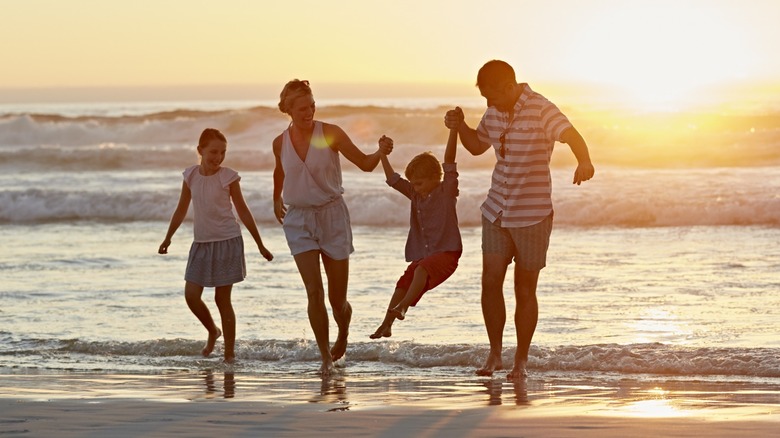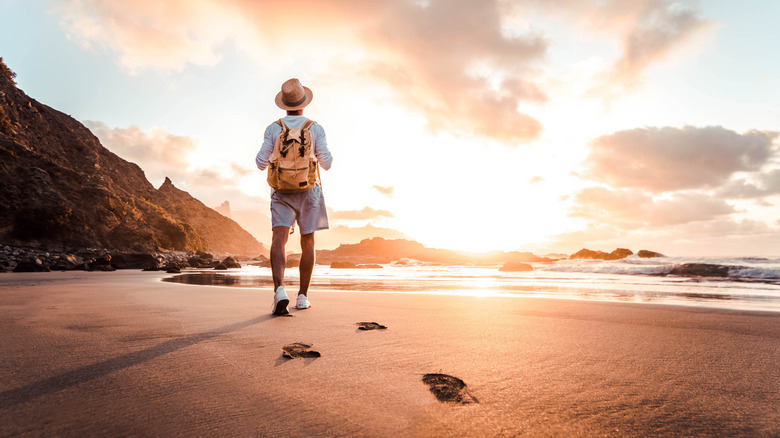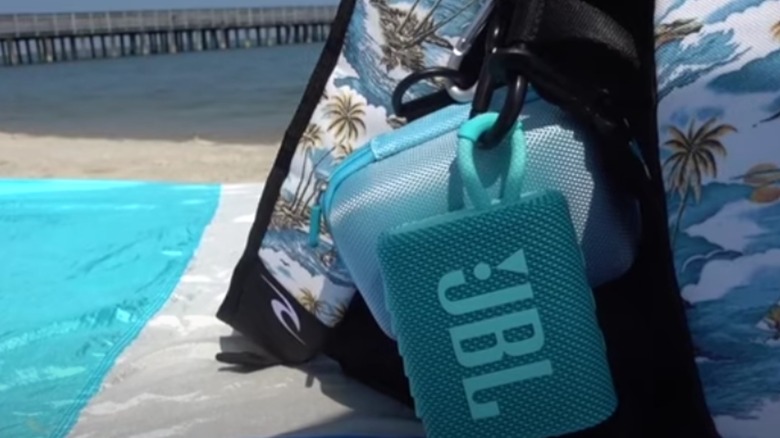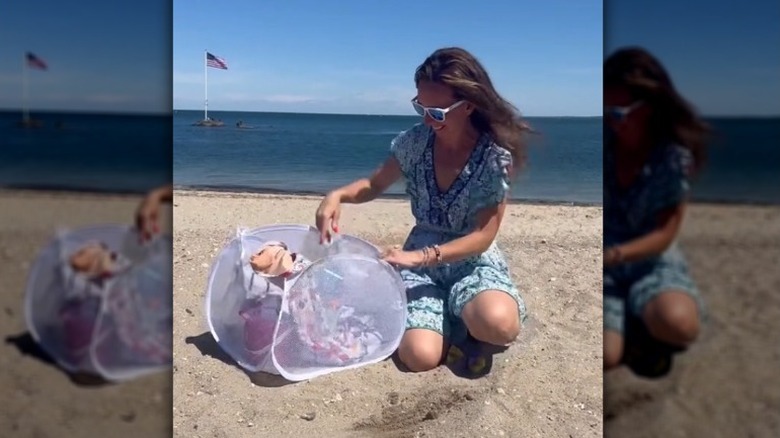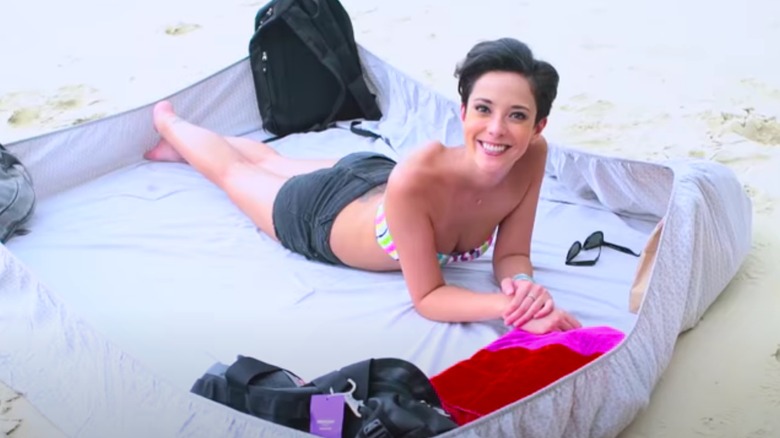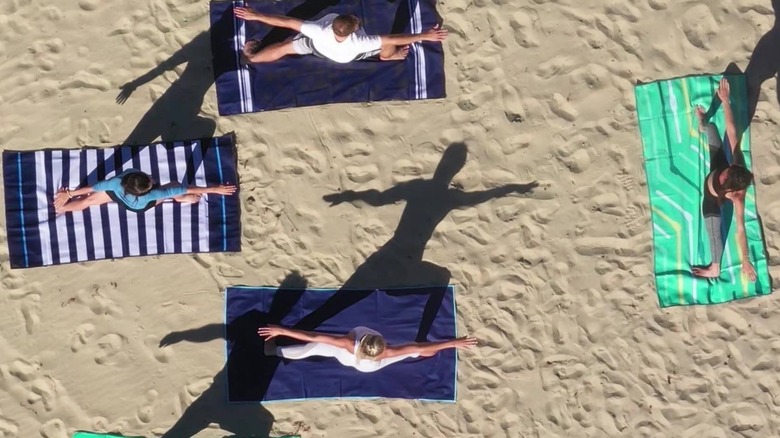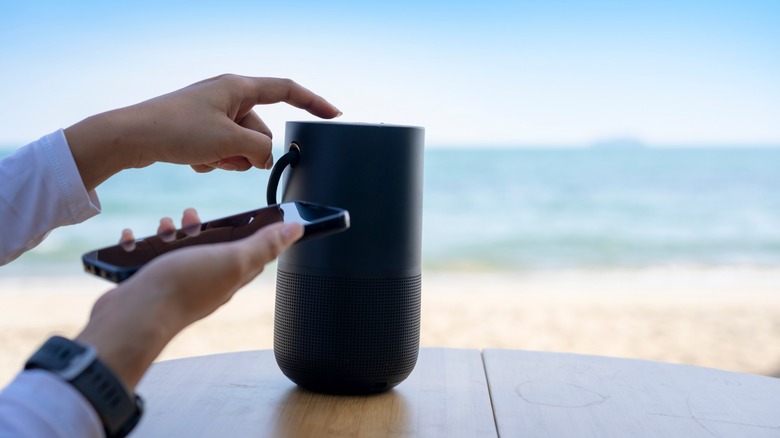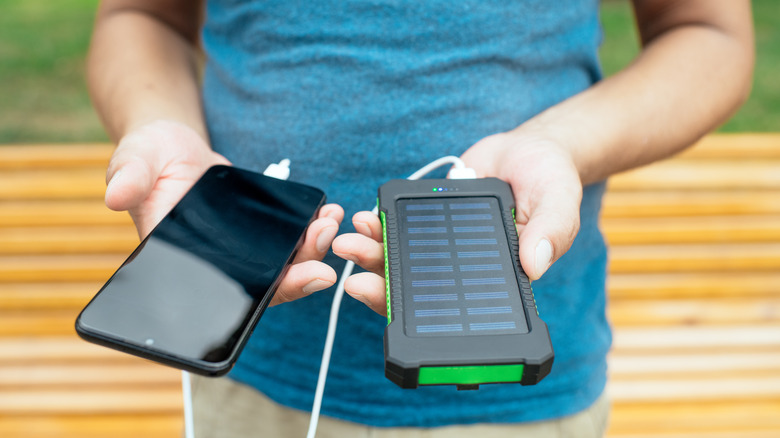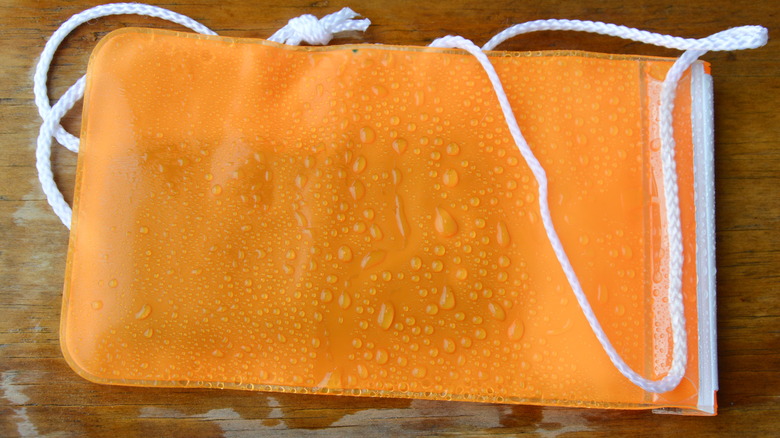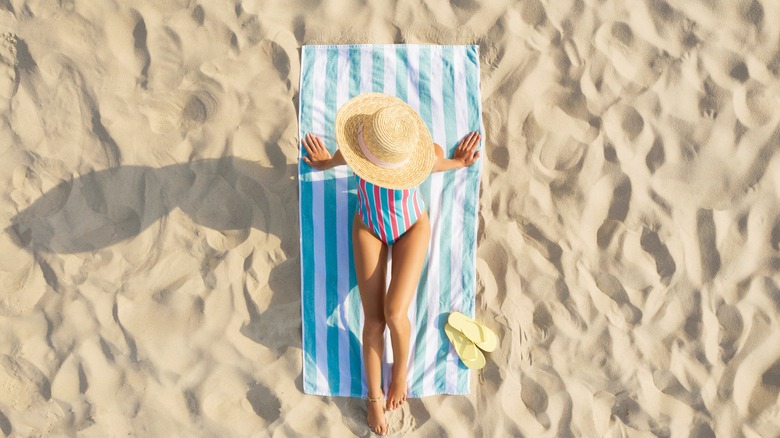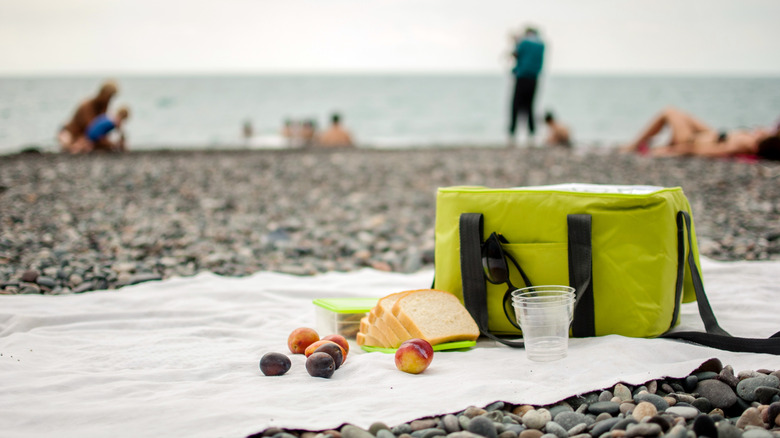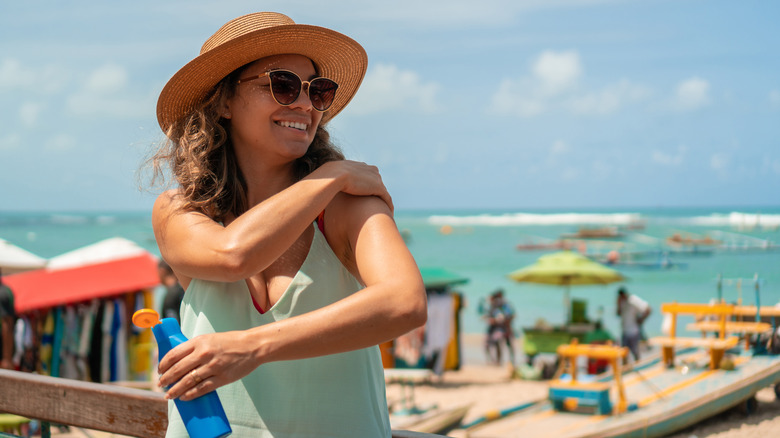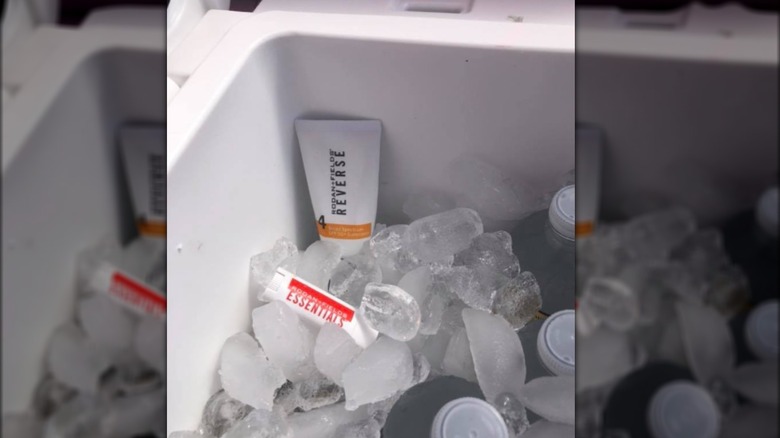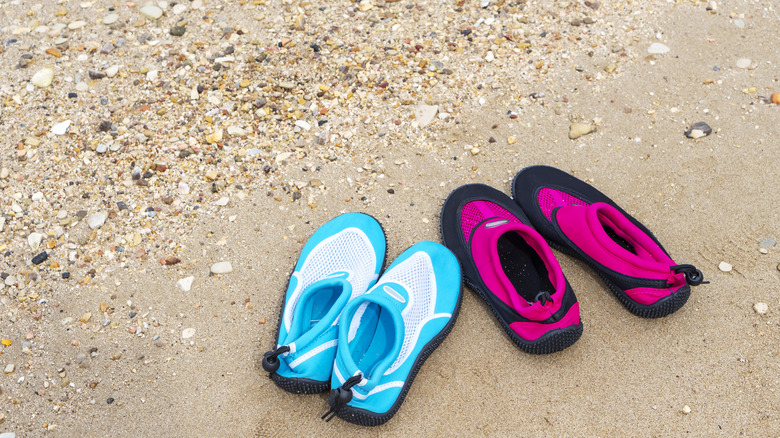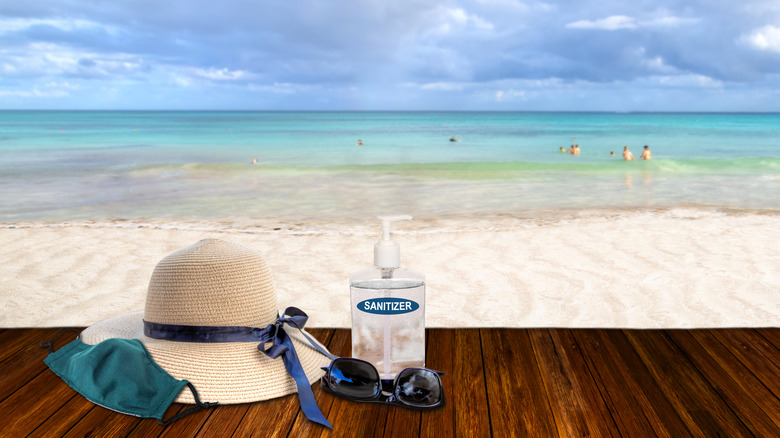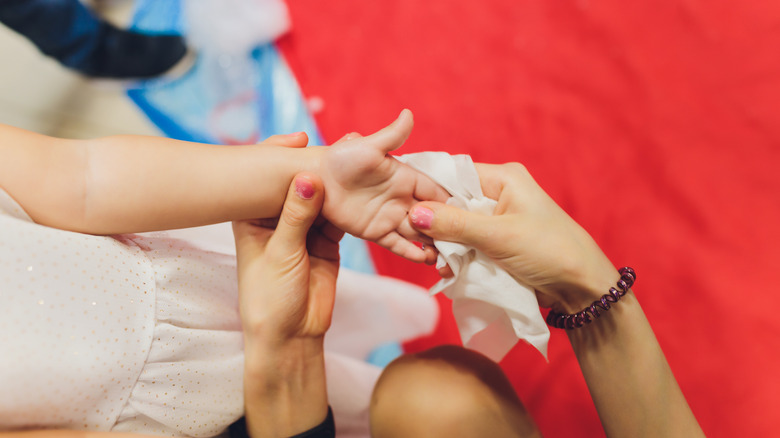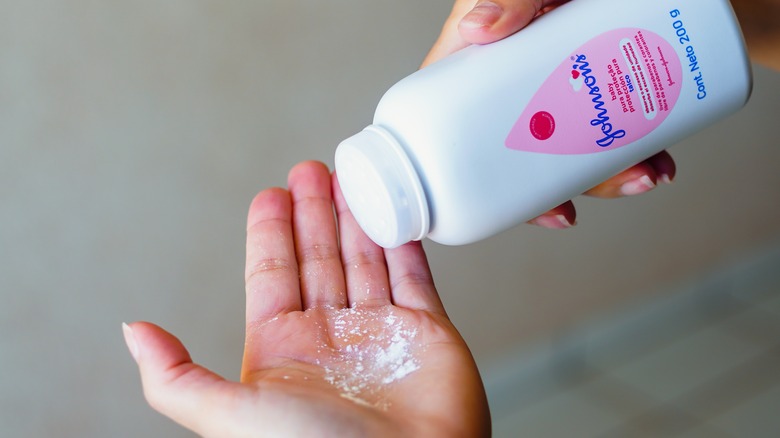The Ultimate Packing Guide For Your Beach Vacation
When the everyday humdrum of all work and no play starts to take a toll, there's nothing like a healthy dose of beach therapy to get you feeling right as rain again. Whether your idea of a day at the beach means splashing around for hours on end or kicking back with a favorite podcast and then watching the sunset over the horizon, there's something purifying about connecting with the water.
When it comes to maximizing your fun in the sun and minimizing your beach day stress levels, having the best beachside setup is essential. And with a little careful planning and special attention to packing the right gear, your day at the beach can be a real walk in the park. From sand-free, comfy beachside lounging to ensuring everyone in your crew stays safe, we've put together the ultimate packing guide for your next beach vacation. The only thing left to worry about is what to add to your playlist!
Forget the tote bag — backpacks are the perfect beach bag
For most folks, a beach bag or tote is their go-to carry-all for beachgoing. But have you ever stopped to wonder why? Beach totes generally have one large compartment, serving as a catch-all for all of your beach day supplies. Sure, they're handy to rummage through, but they're not very organized, and they make it awfully easy for sly thieves to pull a grab-and-go.
In their video guide to packing the perfect beach bag, Haley Cairo of Real Simple makes a strong case for the backpack making an ideal beach bag. Think about it — you can carry it on your back while beachcombing. A good backpack comes equipped with all sorts of dedicated storage space to make accessing everything you need simple, from the water bottle holster to the back pocket where you can keep books or magazines. You can stash your wallet and anything else precious deep inside the bag and then keep it close at hand. And a backpack even doubles as a carry-on bag if you're flying.
Bring extra carabiners and wet bags
After a long day of fun in the sun, it's time to shake off the sand and pack it in for the day. But what do you do with all of those damp towels or wet swimsuits? Sure, you can wring them out and carry them around until you arrive back at the hotel room, but what if you spot someplace cool to stop for a snow cone along the way?
This is why you need a wet bag and a handful of extra carabiners for everyone in your group. Originally designed for handling cloth diapers, wet bags can be incredibly useful for vacations, particularly for stashing soiled laundry or wet swimwear and towels. Purchase one you can hook on with a carabiner and then clip it to your backpack as you're on your way post-beach day. And the great thing about carabiners is that they can instantly expand the storage capacity of your backpack.
A mesh pop-up hamper is the key to sand-free stuff
If you're traveling with kids, you already know a beach day can mean tons of sand getting all over the place. Sand in your towels, sand in shoes — sand in noses and ears! And all of that sand gets tracked into your car, hotel room, or beach house, where it becomes every bit as pervasive as craft glitter.
Leave it to the moms of YouTube to come up with a viral parenting hack that virtually eliminates this problem. Stick a cheap collapsible mesh hamper in with your beach gear and pull it out when you're ready to call it a day. Just grab your kids' sand toys and anything else that needs de-sanding and toss them inside. "You don't even have to clean them off," said Kimberly Wadsworth of The Wads YouTube channel. "Throw them right into the hamper and just shake off the sand ... it's a keeper."
A fitted sheet makes a good sand-free chill spot
If you're the kind of person who likes to impress your friends and loved ones with next-level hacks, you'll absolutely need to throw a fitted sheet into your beach bag. Once you've chosen your perfect beach spot, get someone to help you stretch your fitted sheet out as far as possible, depositing something heavy like a beach bag in each corner to hold it in place and pulling up the corner around it.
This creates a smooth surface that's free of sand, so you don't have to worry about getting the stuff all over your beach towel when you're stretching out to get some much-needed Vitamin D. It also creates a sand-free play space for any kiddos in your party with specific sensory sensitivities. TikTokker Skyler Adams also recommends bringing a water bowl and towel mat to rinse your feet off and keep things extra clean.
Or invest in a large, sand-free beach mat
If you're really serious about your beach time and plan to spend a lot of time out on the sand, it might be worth it to forgo the twin sheet and bring your pro game by investing in a large beach mat designed to repel sand. Unlike your fitted sheet, a good beach mat won't get wet. It also provides a little more cushion between your back and the sand beneath it, which can make beach lounging just that little more comfortable.
A favorite among travel vloggers, CGear manufactures a two-layer, double-mesh beach mat. Per their website, the technology was initially designed to create a smooth and safe helicopter landing mat for military and civilian environments where sand and dust are common. According to TikTokker Beach Gear Guy, any dry sand that lands on it will pass right through, leaving you with a nice, clear surface to relax on.
Don't forget a portable bluetooth speaker
No afternoon on the beach is complete without the perfect summer playlist. But whether you prefer Taylor Swift or The Dillinger Escape Plan, if you plan on using your phone to kick up some tunes at your beach site, you'll need to pack a portable Bluetooth speaker. Even if you're traveling alone, listening to your audiobook or tunes on a speaker is safer than keeping your earbuds in and closing yourself off to the sounds around you.
You don't need anything big or fancy — just something small enough to easily fit in your bag and loud enough to hear outside. You can pick up waterproof speakers, but if you're planning to keep them at your beach site, you're probably fine without this extra feature. Just be sure to make sure your speaker is fully charged before heading out to the beach. And don't crank the volume too high — you are in a public space, after all.
Bring an extra power bank for your phone
While a day on the beach will undoubtedly provide a much-needed screen break, you might be surprised at how quickly your phone battery can fade even when you're not doomscrolling or getting sucked into a TikTok vortex. But between using GPS to find your perfect beach spot, snapping pics, and blasting your yacht rock playlist, your battery can drain pretty quickly.
When you're on vacation, your phone is truly your most important security device, and having it charged could quite literally save a life. Never head to the beach without at least one fully charged power bank and a spare cable or two just for good measure. If you're traveling with a group, it's a good idea to bring one with a large charging capacity and a couple of ports. You can even pick up a solar-charged power bank and take full advantage of your time in the sunshine.
Pack a clear dry bag for your phone and electronics
Your phone might be your best friend on the beach, but the beach can be pretty rough on a phone if you're not careful. Tiny sand particles get everywhere while you're on the beach, and they can even get into your charger or headphone ports. Once inside your ports, it can cause corrosion and seriously damage your phone. And we all know that water is the enemy of phones.
But that doesn't mean you need to leave it in your car where it can get overheated. To keep your phone free of water and sand, be sure to pack a waterproof phone protector with a clear cover. In a pinch, Mobile Tech Addicts say an airtight Ziploc-style baggie will work, and you should still be able to operate the touch screen. Just be careful that the seal is completely closed when using it with wet hands.
Pack a small microfiber towel for drying off
Before you stretch out to catch some rays, it's nice to go for a dip in the ocean. But once you've used your towel to dry off after a refreshing swim, you're stuck with a damp towel, and nobody wants to lie down on a damp towel. Sure, you can bring an extra beach towel along so you've got one for drying off with and one for lying down, but then you're stuck with two towels taking up most of the space in your beach bag. As Real Simple host Haley Cairo puts it, "The backpack is precious real estate, okay? We cannot use all the space for towels."
Cairo says a better solution is to bring along a compact, small microfiber towel instead of two bulky beach towels, emphasizing that the right microfiber towel can even be good for lying on while catching those rays.
A collapsible insulated cooler or tote is less bulky than a hard cooler
It's not always feasible to take a large, hard-side cooler with you when you're beachbound, particularly if you're flying to your destination. And even if you did, it's just another thing to lug around on top of your beach bags and anything else you might want to bring along. At the same time, you don't want to get stuck out in the summer sun without your favorite ice-cold, refreshing beverages.
An insulated cooler is much more compact. Even better, an insulated tote like the one you use to buy frozen foods at the grocery store is collapsible and makes a fine alternative when you're just looking for a spot to stash a few water bottles and Gatorades. If you pack the right one, you can fold it inside your luggage for the flight and fill it with ice at your hotel's ice dispenser before heading out for the afternoon.
Protect your skin with the right sunscreen and hat
It's a common misconception that only light-skinned individuals can get sunburned or skin damage from sun exposure. Even if you've got a decent base tan or a naturally darker skin tone, the sun can have harsh effects on your skin. The same UVA rays that cause skin cancer and sunburns can also leave your skin damaged with dark spots and wrinkles. And the more your skin is exposed to the sun, the greater your risk of skin cancer. It's essential to prioritize sun protection anytime you're on the beach, even if there's some degree of cloud cover.
To fully protect your skin, it's a good idea to use a high-SPF sunscreen of at least 30 printed with the phrase "broad spectrum protection." It's also a good idea to pack a wide-brimmed hat to fully protect your skin. And don't forget to pack a good pair of high-SPF sunglasses.
Store your sunscreen and aloe in an insulated pouch or cooler
Johns Hopkins Medicine recommends reapplying sunscreen every two hours when you're hanging out in the sun. If you're doing much sweating or you've spent any amount of time in the water, you'll need to reapply even more often. But if the idea of reaching for a sunscreen bottle that's been sitting in full sun for hours and heating up to a nice, warm massage oil temperature seems pretty unappealing on a warm beach day, try stashing it in your cooler or a small insulated bag. Throw in an ice pack, and you've got a nice, cool lotion to help bring down the temperature.
If you find yourself with a touch of sunburn, you'll be glad you did. A thermal bag or cooler is also an excellent place to stash your chapstick to keep it from melting in the summer heat.
Choose your beach shoes wisely
The shoes you choose to toss in your beach bag can make or break your beach day experience. Cheap flip-flops are likely to fall apart the first time you get seriously stuck in wet sand or float away in the water. Worse, they can end up added to the ocean's growing collection of discount store detritus and release harmful chemicals as their synthetic plastic degrades. Although other types of slip-on shoes (like Birkenstocks) can be a little better, it's probably best to go with a shoe that won't slip off of your feet. And cuter options — like espadrilles — tend not to be waterproof and can get pretty uncomfortable when sand gets inside.
A good water or beach shoe will be waterproof with a rubber sole that gives enough grip to help you easily trek through wet sand and walk over rockier areas. Consider investing in a quality mesh water shoe or a good pair of waterproof Teva-style shoes for your beachcombing adventure.
Hand sanitizer is a must
If you don't already carry a pocket-sized hand sanitizer everywhere you go, it's a must-have addition to your beach bag. Even though the salt in briny seawater has a few natural antibacterial properties, saltwater will not kill all of the bacteria you encounter while you're in the ocean. And if we learned nothing else in the pandemic, it's that it's never a bad idea to do a little preventative sanitizer spritz.
Choosing a foaming sanitizer to pop into your small insulation pouch can make freshening up your hands even fresher. And if all that sticky salt and sand make you feel like something that crawled out of Davy Jones' locker, a lovely scented sanitizer can help cut out some of the ick factor. A small, travel-sized pack of hand sanitizer wipes can also make a delightful alternative — especially if you've got kiddos in your beach party.
Body wipes are a sweat eraser
If your hands aren't the only part of you that feels grimy after hanging out in the saltwater and sun, body wipes are a great thing to stash in your beach bag. All of that sweat in the summer heat can leave your skin oily. Factor in the feeling of sand stuck to your skin, and it can make lying in the sun pretty unpleasant — particularly for those who have sensory issues. And if you plan to stop anywhere for dinner before you head back, that sticky feeling can be downright miserable.
When you're on a beach without a beach shower and you need to clean up a bit, a refreshing pack of body wipes can be almost as effective. Just be sure to take them with you when you leave. According to the Marine Conservation Society, wet wipes are a major source of beach pollution. To keep yours under wraps, take a plastic store bag and keep it in your backpack to dispose of back in your hotel room.
Baby powder is good for banishing sand
Whether your day at the beach was all about beachcombing, sunbathing, or sandcastle building, there's a good chance you're going to end up with sand all over you — in your hair, on your skin, and all over your belongings. According to Popular Science, that's because sand is naturally hydrophilic, meaning it likes water, and water likes it. Since even the air near the ocean can be a little wet, you can pretty much bet you'll end up covered in the stuff. But with just a little silicate-free baby powder and a spare sock, you can avoid dragging loads of microscopic souvenirs back to your hotel room.
Baby powder has an absorbent property to soak up that moisture, causing sand to lose its stickiness and fall to the ground. YouTuber Lauren Clutter recommends filling a sock with powder and brushing it over any sandy skin to leave your skin free of sand and ready for the next big adventure.
